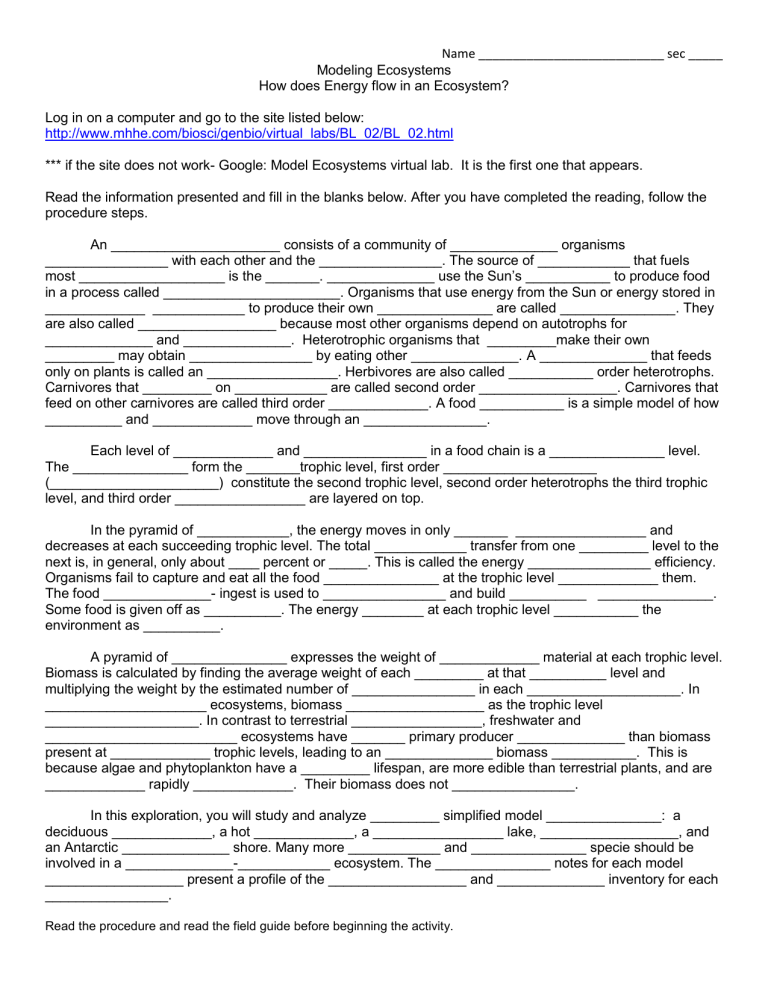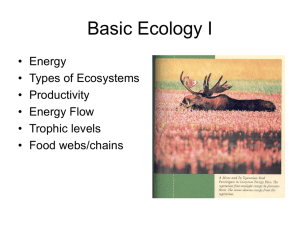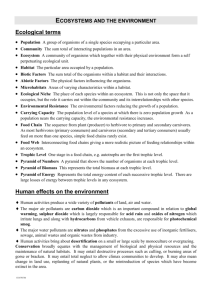
Name ___________________________ sec _____ Modeling Ecosystems How does Energy flow in an Ecosystem? Log in on a computer and go to the site listed below: http://www.mhhe.com/biosci/genbio/virtual_labs/BL_02/BL_02.html *** if the site does not work- Google: Model Ecosystems virtual lab. It is the first one that appears. Read the information presented and fill in the blanks below. After you have completed the reading, follow the procedure steps. An ______________________ consists of a community of ______________ organisms ________________ with each other and the ________________. The source of ____________ that fuels most ___________________ is the _______. ______________ use the Sun’s ___________ to produce food in a process called _______________________. Organisms that use energy from the Sun or energy stored in _____________ ____________ to produce their own _______________ are called _______________. They are also called __________________ because most other organisms depend on autotrophs for ______________ and ______________. Heterotrophic organisms that _________make their own _________ may obtain ________________ by eating other ______________. A ______________ that feeds only on plants is called an _________________. Herbivores are also called ___________ order heterotrophs. Carnivores that _________ on ____________ are called second order __________________. Carnivores that feed on other carnivores are called third order _____________. A food ___________ is a simple model of how __________ and _____________ move through an ________________. Each level of _____________ and ________________ in a food chain is a _______________ level. The _______________ form the _______trophic level, first order ____________________ (______________________) constitute the second trophic level, second order heterotrophs the third trophic level, and third order _________________ are layered on top. In the pyramid of ____________, the energy moves in only _______ _________________ and decreases at each succeeding trophic level. The total ____________ transfer from one _________ level to the next is, in general, only about ____ percent or _____. This is called the energy ________________ efficiency. Organisms fail to capture and eat all the food _______________ at the trophic level _____________ them. The food ______________- ingest is used to ________________ and build __________ _______________. Some food is given off as __________. The energy ________ at each trophic level ___________ the environment as __________. A pyramid of _______________ expresses the weight of _____________ material at each trophic level. Biomass is calculated by finding the average weight of each _________ at that __________ level and multiplying the weight by the estimated number of ________________ in each ____________________. In _____________________ ecosystems, biomass __________________ as the trophic level ____________________. In contrast to terrestrial _________________, freshwater and _________________________ ecosystems have _______ primary producer ______________ than biomass present at _____________ trophic levels, leading to an ______________ biomass ___________. This is because algae and phytoplankton have a _________ lifespan, are more edible than terrestrial plants, and are _____________ rapidly _____________. Their biomass does not ________________. In this exploration, you will study and analyze _________ simplified model _______________: a deciduous _____________, a hot _____________, a _________________ lake, __________________, and an Antarctic ______________ shore. Many more ____________ and _______________ specie should be involved in a ______________-____________ ecosystem. The _______________ notes for each model __________________ present a profile of the __________________ and ______________ inventory for each ________________. Read the procedure and read the field guide before beginning the activity. Name ___________________________ sec _____ Then click on an ecosystem, and begin with the procedure. You will need to place all organisms in the levels before you can get the pyramid data for numbers and energy. Complete these steps for all five ecosystems, fill in the information for each ecosystem in the data table. Once the data table is complete, answer the journal questions. Ecosystem Producers Energy number Deciduous Forest Hot Desert First Order Heterotrophs Energy Energy Energy conversion number conversion efficiency efficiency (a decimal) 100 100 Grassland 100 Antarctic Ocean Floor 100 Freshwater Lake 100 Second Order Heterotrophs Energy Energy number conversion efficiency (a decimal) Third Order Heterotrophs Energy Energy number conversion efficiency (a decimal)





